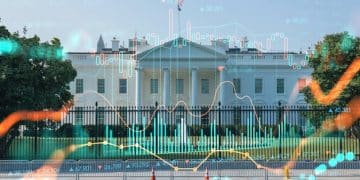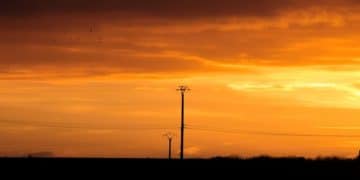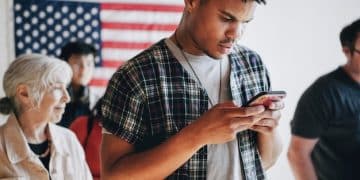Supreme Court to Review Student Loan Forgiveness: Arguments & Outcomes
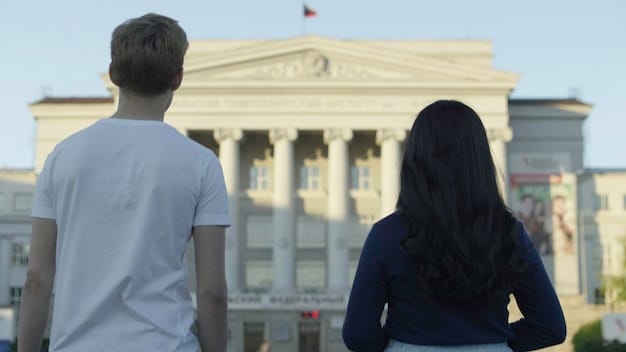
The Supreme Court is set to hear arguments on the Biden administration’s student loan forgiveness program, a plan that could potentially cancel up to $20,000 in debt for millions of borrowers, facing legal challenges regarding its authority and economic impact.
The Supreme Court to Hear Case on Student Loan Forgiveness Program – Arguments and Potential Outcomes promises to be a landmark decision impacting millions of Americans. The Biden administration’s ambitious plan to alleviate student debt faces scrutiny, raising critical questions about executive power and economic consequences. Let’s delve into the heart of this legal battle.
The Genesis of the Student Loan Forgiveness Program
The Student Loan Forgiveness Program emerged as a response to the growing burden of student debt on Americans, particularly exacerbated by the economic fallout from the COVID-19 pandemic. The Biden administration framed it as a measure to stimulate the economy and provide relief to those struggling with their finances.
The Biden Administration’s Rationale
The administration argued that the program was authorized under the HEROES Act of 2003, which grants the Secretary of Education the authority to waive or modify student financial assistance programs during a national emergency. They contended that the pandemic qualified as such an emergency, justifying the broad scope of the forgiveness plan.
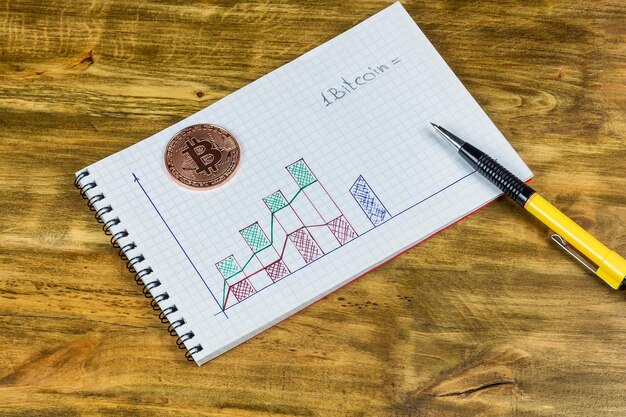
Key Provisions of the Program
- Up to $20,000 in debt cancellation for Pell Grant recipients.
- Up to $10,000 in debt cancellation for non-Pell Grant recipients.
- Eligibility limited to borrowers earning less than $125,000 individually or $250,000 per household.
In conclusion, the program’s origins are rooted in addressing the student debt crisis and the economic challenges posed by the pandemic. The administration asserts its authority through the HEROES Act, while opponents question the legality and scope of the plan.
Legal Challenges and the Supreme Court’s Role
Multiple lawsuits were filed challenging the legality of the Student Loan Forgiveness Program. These lawsuits raised concerns about the administration’s authority to enact such a sweeping program without explicit congressional authorization. Several states and conservative groups argued they would suffer economic harm as a result of the loan forgiveness.
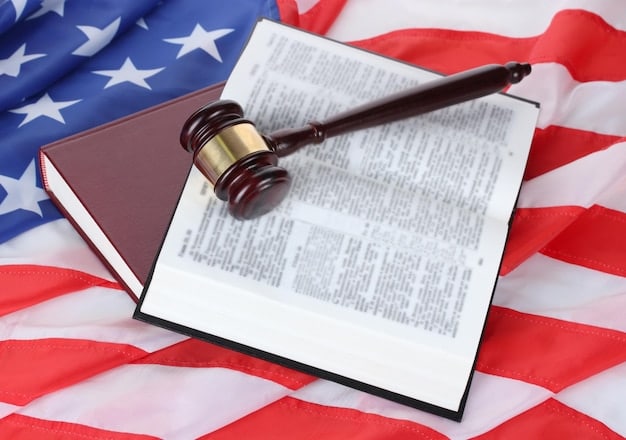
Arguments Against the Program
- The plaintiffs argue that the HEROES Act does not authorize such broad debt cancellation.
- They claim the program exceeds the Secretary of Education’s authority.
- Several states argue they will lose tax revenue due to the forgiven debt.
The Supreme Court’s Decision to Hear the Case
The Supreme Court agreed to hear the case, recognizing the significant legal and economic implications of the program. The court’s decision will determine whether the Biden administration has the authority to proceed with its student loan forgiveness plan.
In conclusion, the legal challenges to the program center on the scope of executive power and the interpretation of existing laws. The Supreme Court’s decision will have a profound impact on the future of student loan forgiveness and the balance of power between the executive and legislative branches.
The Key Legal Arguments in Detail
The legal arguments presented before the Supreme Court are complex and multifaceted. They delve into the interpretation of statutes, the scope of executive authority, and the potential economic consequences of the Student Loan Forgiveness Program. The core of the debate surrounds whether the HEROES Act provides sufficient authorization for the sweeping debt relief proposed by the Biden administration.
The HEROES Act and its Interpretation
The Biden administration’s legal defense heavily relies on the HEROES Act of 2003, which grants the Secretary of Education certain powers during a national emergency. The administration argues that the COVID-19 pandemic constitutes such an emergency, allowing the Secretary to waive or modify student financial assistance programs. However, opponents argue that the HEROES Act was intended for targeted relief, not a blanket cancellation of debt.
“Major Questions Doctrine”
Opponents of the program are employing the “major questions doctrine,” which asserts that Congress must explicitly authorize executive agencies to make decisions of vast economic and political significance. They argue that the student loan forgiveness program, which could cost hundreds of billions of dollars, falls under this doctrine and requires clear authorization from Congress.
The crux of the legal debate lies in interpreting the HEROES Act and applying the “major questions doctrine.” The Supreme Court’s decision will likely hinge on how it weighs these competing legal principles and their relevance to the specific context of the student loan forgiveness program. Arguments on both sides hinge on technical, legal interpretations.
Potential Outcomes and Their Implications
The Supreme Court’s decision could have a range of potential outcomes, each with significant implications for millions of student loan borrowers and the broader economy. The court could uphold the program, strike it down entirely, or issue a narrower ruling that allows for some, but not all, of the proposed debt relief.
Upholding the Program
If the Supreme Court upholds the program, millions of borrowers could see their student loan debt significantly reduced or eliminated. This could provide substantial financial relief to individuals and families, potentially boosting consumer spending and stimulating the economy. Those struggling with payments would find relief.
Striking Down the Program
If the Supreme Court strikes down the program, the Biden administration’s student loan forgiveness plan would be blocked. Student loan payments, which have been paused since the start of the pandemic, would likely resume. Millions of borrowers would remain burdened by their existing student debt, potentially hindering their financial well-being. There would be many unhappy citizens and negative publicity.
A Narrower Ruling
The Supreme Court could issue a narrower ruling that allows for some debt relief but limits the scope of the program. For example, the court could uphold debt cancellation for Pell Grant recipients but strike down forgiveness for non-Pell Grant recipients. This would result in a mixed outcome, providing relief to some borrowers while leaving others behind. It would be a political compromise that would please neither side.
In conclusion, the potential outcomes of the Supreme Court’s decision range from full implementation of the program to its complete rejection. Each outcome would have significant economic and social consequences, shaping the future of student loan debt and the financial well-being of millions of Americans. The impacts of any decision will be far-reaching.
The Political and Economic Repercussions
Beyond the legal arguments, the Supreme Court’s decision carries significant political and economic repercussions. The Student Loan Forgiveness Program has become a highly politicized issue, with strong opinions on both sides. The court’s ruling will likely further inflame these divisions and could have implications for future elections.
Political Fallout
- A ruling against the program could energize Republican voters.
- A ruling in favor could galvanize Democratic support.
- The decision could impact the 2024 presidential election.
Economic Effects
Economists are divided on the potential economic effects of the program. Supporters argue that debt forgiveness would stimulate the economy by freeing up borrowers’ disposable income. Opponents worry about the inflationary impact of the program and the potential for moral hazard, encouraging future borrowing. The plan could be a form of economic stimulus.
The political and economic stakes are high. The ruling will likely resonate far beyond the legal realm, influencing political discourse and shaping economic policy for years to come. Both parties are focused on the potential implications.
Looking Ahead: Potential Paths Forward
Regardless of the Supreme Court’s decision, the issue of student loan debt is likely to remain a prominent concern for policymakers. There are several potential paths forward, including legislative action, alternative debt relief programs, and reforms to the student loan system.
Legislative Action
Congress could pass legislation to address student loan debt, either by authorizing a debt forgiveness program or by reforming the student loan system. However, given the current political polarization, it may be difficult to reach a consensus on such legislation. A new bill could potentially offer a compromise.
Alternative Debt Relief Programs
The Biden administration could explore alternative debt relief programs that may be less susceptible to legal challenges. For example, the administration could expand existing income-driven repayment plans or offer targeted relief to borrowers in specific circumstances. This could potentially offer more narrowly tailored solutions.
Reforms to the Student Loan System
Longer-term, reforms to the student loan system may be necessary to prevent future debt crises. Such reforms could include measures to control tuition costs, increase transparency in student loan lending, and provide better financial education to students. Changes to the overall system could have the most far-reaching effects.
In conclusion, student loan debt is a complex and multifaceted issue that requires a comprehensive policy response. The Supreme Court’s decision will shape the immediate future, but longer-term solutions will require sustained effort and cooperation from policymakers, educators, and borrowers alike. Further action will likely be necessary, regardless of the decision.
| Key Point | Brief Description |
|---|---|
| ⚖️ Legal Challenges | Multiple lawsuits question the program’s legality. |
| 💰 Economic Impact | Mixed opinions on inflation and economic stimulus. |
| 🗳️ Political Repercussions | The decision could impact future elections. |
| 🎓 Potential Outcomes | Program upheld, struck down, or a narrower ruling. |
FAQ
▼
The program aims to cancel up to $20,000 in student loan debt for Pell Grant recipients and up to $10,000 for non-Pell Grant recipients, subject to income limits.
▼
Legal challenges question the Biden administration’s authority to enact such a broad debt cancellation program without explicit congressional authorization.
▼
The HEROES Act of 2003 allows the Secretary of Education to waive or modify student financial assistance programs during a national emergency, which the administration says includes the pandemic.
▼
Supporters say it would stimulate the economy, while opponents worry about inflation and the potential for increased borrowing caused by moral hazard.
▼
If struck down by the Supreme Court, the student loan forgiveness plan would be blocked, and student loan payments would likely resume for millions of borrowers.
Conclusion
The Supreme Court’s decision on the student loan forgiveness program carries immense weight, impacting millions of Americans and potentially reshaping the landscape of higher education financing. The arguments are complex, and the outcomes uncertain, but the implications are clear: this ruling will have lasting economic, political, and social repercussions.


